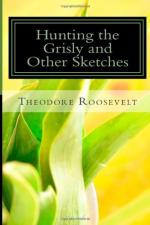When camp was pitched the horses were turned loose to graze and refresh themselves after their trying journey, during which they had lost flesh woefully. They were watched and tended by the two men who were always left in camp, and, save on rare occasions, were only used to haul in the buffalo hides. The camp-guards for the time being acted as cooks; and, though coffee and flour both ran short and finally gave out, fresh meat of every kind was abundant. The camp was never without buffalo-beef, deer and antelope venison, wild turkeys, prairie-chickens, quails, ducks, and rabbits. The birds were simply “potted,” as occasion required; when the quarry was deer or antelope, the hunters took the dogs with them to run down the wounded animals. But almost the entire attention of the hunters was given to the buffalo. After an evening spent in lounging round the campfire and a sound night’s sleep, wrapped in robes and blankets, they would get up before daybreak, snatch a hurried breakfast, and start off in couples through the chilly dawn. The great beasts were very plentiful; in the first day’s hunt twenty were slain; but the herds were restless and ever on the move. Sometimes they would be seen right by the camp, and again it would need an all-day’s tramp to find them. There was no difficulty in spying them—the chief trouble with forest game; for on the prairie a buffalo makes no effort to hide and its black, shaggy bulk looms up as far as the eye can see. Sometimes they were found in small parties of three or four individuals, sometimes in bands of about two hundred, and again in great herds of many thousands; and solitary old bulls, expelled from the herds, were common. If on broken land, among the hills and ravines, there was not much difficulty in approaching from the leeward; for, though the sense of smell in the buffalo is very acute, they do not see well at a distance through their overhanging frontlets of coarse and matted hair. If, as was generally the case, they were out in the open, rolling prairie, the stalking was far more difficult. Every hollow, every earth hummock and sagebush had to be used as cover. The hunter wriggled through the grass flat on his face, pushing himself along for perhaps a quarter of a mile by his toes and fingers, heedless of the spiny cactus. When near enough to the huge, unconscious quarry the hunter began firing, still keeping himself carefully concealed. If the smoke was blown away by the wind, and if the buffaloes caught no glimpse of the assailant, they would often stand motionless and stupid until many of their number had been slain, the hunter being careful not to fire too high, aiming just behind the shoulder, about a third of the way up the body, that his bullet might go through the lungs. Sometimes, even after they saw the man, they would act as if confused and panic-struck, huddling together and staring at the smoke puffs; but generally they were off at a lumbering gallop as soon as they had an idea of the point of danger. When once started, they ran for many miles before halting, and their pursuit on foot was extremely laborious.




